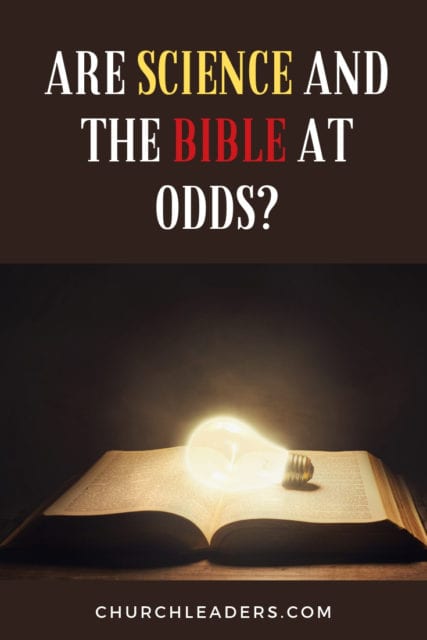~ Modern Interpretations of Genesis 1 ~
Toward the end of the 18th century, two developments provided an impetus for more thinking and debate over the interpretation of Genesis 1: the new discipline of geology and archaeological discoveries. Two groups of thought emerged: Concordism, which is the supposition that the biblical teaching in Genesis can and should be harmonized to the developing scientific theories, and Non-Concordism, which does not try to harmonize biblical text with science because it doesn’t believe the intent of the biblical writer was to address modern science.
Concordist interpretations are driven by what some believe are remarkable agreements between the biblical text and modern science. Astronomer Robert Jastrow, for instance, has said, “Astronomers now find they have painted themselves into a corner because they have proven, by their own methods, that the world began abruptly in an act of creation… That there are what I or anyone would call supernatural forces at work is now, I think, a scientifically proven fact.”
Concordists hold to one of two views concerning the age of the earth. “Old Earth” interpretations accept the mainstream scientific dating of 4.5 billion years. “Young Earth” interpretations claim the earth is 6,000-10,000 years old. The Young Earth views, rather than harmonizing with mainstream science, believe that mainstream science has incorrectly concluded that the earth is ancient and that the scientific evidence needs to be reconsidered.
Non-Concordist interpretation is driven by the desire to understand how early ancient Near East readers would have understood the text, given that the worldview of the original audience differs greatly from modern worldviews. As much as we’d like to do so, writes John Lennox in his book Seven Days That Divide the World: The Beginning According to Genesis and Science, “we cannot simply read it as if it were a Western document written to address contemporary Western concerns.”
Let’s look first at Concordist interpretations, starting with those who believe the earth to be quite old and finishing with those who believe it to be quite young:
~ Old-Earth Creationism (OEC)
OEC accepts standard scientific dating for the age of the universe. This does not mean, however, that OEC necessarily embraces some form of evolution. In other words, evolution requires an old earth, but just because the earth is old does not mean evolution is true.
Those who hold to the Gap View believe that an undefined period of rebellion followed God’s creation of a perfect universe and earth, during which Satan was cast to earth. This view posits that the “gap” between Genesis 1:1 and Genesis 1:2 could have lasted millions of years. This view, however, has grown out of favor with recent scholars.
Those who hold to the Day-Age View maintain that the days of creation are long but finite periods of time: “ages.” They note that the Hebrew word for day, yom, has different meanings depending on the context in which it is used. Specifically, Day-Age proponents argue that the amount of activity in the sixth day implies the passage of more time than a calendar day, that Adam’s response to Eve in Genesis 2:23 (“this at last is….) suggests a long period had elapsed between the time Adam began his work of naming animals and the creation of Eve, and that the absence of an end to the seventh day implies that we are still in this day.
Those who hold to the Intermittent Day View believe that the creation events described in Genesis occurred over a long period of time, subdivided into six parts, which is introduced by a literal day. This theory provides harmony between the interpretation of yom as a literal calendar day and today’s mainstream scientific view that the events described in Genesis 1 must have occurred over long periods of time.
Those who hold to the Days of Divine Fiat View argue that Genesis doesn’t describe six days of God working, but the days on which God issued His creative commands or “fiats.” Proponents of this theory believe the actual time taken for the outworking of creation can be estimated by modern scientific methods. The perspective here is God’s perspective from heaven: God stepped out on nothing in the inky blackness of eternity and simply spoke creation into existence.
~ Young-Earth Creationism (YEC)
YEC generally holds that the whole universe is as young as the earth. YEC questions the reliability and assumptions of many popular dating techniques used by the mainstream scientific community. YEC counters that there is much evidence that point to a young earth, and that although mainstream science has been biased toward an ancient earth, it is through the biblical view of six days of creation that all scientific evidence must be viewed.
Some proponents of YEC believe in the validity of the 24-Hour View, which claims that God created the world in six, literal 24-hour days, as Genesis records. Arguments made for this theory include that the text wording “Evening came and then morning” seems to indicate a literal day, that Sabbath rest seems to imply six literal days of work during the creation week, and that although the sun was created on day four, there was life on day three (Genesis 1:11-13). As life can’t exist for long periods without sunlight, they assert, the days were not long ages.
The Mature Creation View also holds that creation took place over six 24-hour days. But here, God created the universe and all that is in it with the appearance of age.












